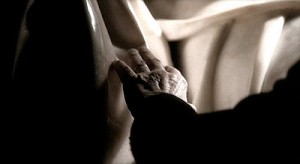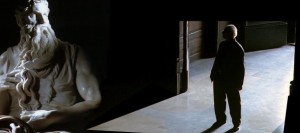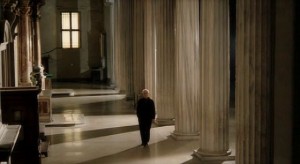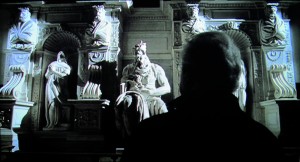Written for Rouge No. 4 (2004). The film can be accessed here. — J.R.
The Gaze of Antonioni
Jonathan Rosenbaum
Surfacing without press screenings at a few theatres in the Landmark arthouse chain in the US for two weekend screenings in mid-August, Michelangelo Antonioni’s 17-minute Lo Sguardo di Michelangelo may conceivably be his most interesting film since Red Desert (1964). It’s hard to be sure of this after only one look at it – the film was abruptly withdrawn after qualifying for an Oscar nomination – but I thought afterwards that I might have just seen one of the first truly durable reflections to date on digital cinema.
Mislabelled Michelangelo Eye to Eye in English when a more accurate English title might be The Gaze of Michelangelo, this beautifully filmed meditation is preceded by an intertitle – the only words in the film apart from the credits – explaining that Antonioni has been confined to a wheelchair since his stroke in 1985, but through the ‘magic of movies’ shows himself visiting the sculpture on foot. The action consists of Antonioni – walking without a cane, and looking like Antonioni prior to his stroke – entering the St. Pietro church in Rome to look at and then touch and caress portions of the restoration of Michelangelo’s Moses, then leaving again. It sounds quite simple, despite the digital trickery that made it possible, but like the montage sequence at the end of L’Eclisse (1962), this is a very intricate (and beautifully intricate) simplicity, in terms of framing as well as editing. Conceptually it might be described as one restoration interacting with another restoration – a spectacle that, like all of Antonioni’s greatest films, pointedly raises more questions than it dares to answer, and preserves more mysteries than it can dream of resolving.




